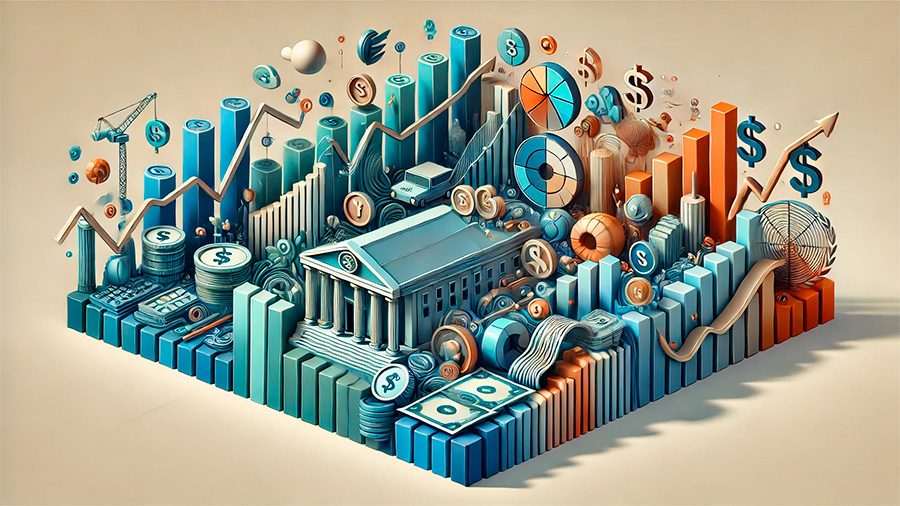When economies face crises, such as recessions or financial downturns, governments and central banks step in to stabilize the economy and encourage growth. The two primary tools they use to combat these crises are fiscal policy and monetary policy. Each plays a unique role in managing economic conditions, but they have different mechanisms, goals, and impacts. Understanding the differences between these two approaches is essential for grasping how governments and central banks work to restore economic stability.
What Is Fiscal Policy?
Fiscal policy refers to the use of government spending and tax policies to influence economic activity. It is typically controlled by the national government, including decisions made by legislatures and executive branches. The key goal of fiscal policy is to manage the economy by either stimulating growth during downturns or cooling down an overheated economy.
Key Components of Fiscal Policy
Government Spending: One of the primary tools of fiscal policy is government spending on infrastructure, public services, and other projects. During a crisis, increased government spending can create jobs, boost demand, and stimulate economic activity. This is often seen in the form of stimulus packages or public investment projects.
Taxation: Another major component of fiscal policy is tax policy. Governments can adjust tax rates to influence the economy. For example, during an economic downturn, the government may reduce taxes to increase disposable income for consumers and businesses, encouraging spending and investment.
How Fiscal Policy Works During Economic Crises
When a country faces an economic crisis, governments often implement expansionary fiscal policy to stimulate the economy. This involves increasing government spending and/or cutting taxes. The goal is to boost demand by putting more money into the hands of consumers and businesses, encouraging them to spend and invest.
For example, during the 2008 financial crisis, many governments around the world implemented large fiscal stimulus packages that included tax cuts and increased spending on infrastructure projects. These measures were designed to prevent a deeper recession by boosting economic activity.
However, fiscal policy has its limitations. One of the key challenges is that government spending often leads to increased public debt, which can be unsustainable in the long term. Additionally, implementing fiscal policy can be slow, as it requires political approval and coordination, which may delay its impact.

What Is Monetary Policy?
Monetary policy refers to the actions taken by a country’s central bank to control the money supply, interest rates, and inflation. The primary aim of monetary policy is to manage economic stability by influencing the cost and availability of credit. Central banks, such as the Federal Reserve in the United States or the European Central Bank, are responsible for setting monetary policy independently of the government.
Key Components of Monetary Policy
Interest Rates: Central banks use interest rates to regulate economic activity. During a crisis, they may lower interest rates to make borrowing cheaper for businesses and consumers, encouraging spending and investment. Conversely, they raise interest rates to curb inflation when the economy is growing too quickly.
Open Market Operations: Central banks can buy or sell government securities in the open market to influence the money supply. By purchasing securities, they inject money into the economy, while selling securities reduces the money supply.
Quantitative Easing (QE): During severe crises, central banks may use a tool known as quantitative easing, which involves buying financial assets, such as government bonds or corporate debt, to increase liquidity in the financial system. This helps keep credit flowing when traditional monetary tools, like lowering interest rates, are not enough to stimulate the economy.
How Monetary Policy Works During Economic Crises
During economic crises, central banks typically implement expansionary monetary policy to stimulate the economy. The most common method is lowering interest rates to make borrowing more affordable for consumers and businesses. By reducing the cost of loans, central banks encourage people to spend and invest, which helps boost economic activity.
For instance, in response to the COVID-19 pandemic, central banks worldwide slashed interest rates to near zero and launched aggressive quantitative easing programs to ensure that financial markets remained liquid and businesses had access to credit.
While monetary policy is often more flexible and quicker to implement than fiscal policy, it also has limitations. Interest rates can only be lowered to a certain point, and when they are already near zero, central banks have fewer tools available. Additionally, monetary policy is more indirect, meaning it may take time for its effects to trickle down to the broader economy.
Key Differences Between Fiscal and Monetary Policy
Although both fiscal and monetary policy aim to stabilize the economy, they differ in terms of tools, decision-makers, and how they impact the economy.
Decision-Makers and Implementation
Fiscal Policy: Fiscal policy is set by the government—typically by the legislature and executive branches. Because it involves government spending and taxes, it often requires political approval, which can lead to delays in implementation.
Monetary Policy: Monetary policy is managed by central banks, which operate independently of the government. This allows central banks to make decisions more quickly, based on economic data, without the need for political approval.
Tools Used
Fiscal Policy: Uses government spending and taxation to influence economic activity. For example, a government may invest in public infrastructure or reduce taxes to stimulate demand.
Monetary Policy: Uses interest rates, open market operations, and the money supply to regulate economic conditions. Central banks adjust these tools to manage inflation and stimulate economic growth.
Impact on the Economy
Fiscal Policy: Directly affects aggregate demand through government spending or taxation. It can have an immediate impact on jobs, infrastructure, and public services. However, it can also increase government debt if not managed carefully.
Monetary Policy: Indirectly affects the economy by influencing borrowing costs and the availability of credit. It can take longer for the effects of monetary policy to be felt by consumers and businesses, but it can also be adjusted more frequently based on real-time economic conditions.

When Fiscal and Monetary Policies Work Together
During severe economic crises, fiscal and monetary policies often work in tandem to stabilize the economy. Governments and central banks coordinate their efforts to ensure that both spending and credit are available to stimulate growth. The effectiveness of this coordination was particularly evident during the 2008 financial crisis and the COVID-19 pandemic.
The 2008 Financial Crisis Example
During the 2008 global financial crisis, many governments launched large fiscal stimulus programs, including tax cuts and public spending on infrastructure, while central banks lowered interest rates and initiated quantitative easing programs. This coordinated approach helped stabilize financial markets, prevent a deeper recession, and eventually led to recovery.
COVID-19 Pandemic Response
In response to the COVID-19 pandemic, governments around the world rolled out fiscal stimulus packages, including direct payments to households, business loans, and unemployment benefits. At the same time, central banks slashed interest rates, launched asset purchase programs, and provided liquidity to financial institutions. The combined efforts of fiscal and monetary policy helped prevent an even more severe economic downturn and supported the recovery as countries emerged from the pandemic.
Challenges and Risks of Fiscal and Monetary Policies
While fiscal and monetary policies can be highly effective in combating economic crises, they also come with risks and challenges. One major risk of expansionary fiscal policy is the potential for rising government debt. If governments borrow too much to fund stimulus programs, it can lead to long-term fiscal imbalances and increase the risk of inflation.
On the monetary side, overly aggressive expansionary policies—such as keeping interest rates too low for too long—can lead to asset bubbles, excessive risk-taking, and future inflation. Central banks must carefully balance their actions to ensure they support economic growth without creating instability in financial markets.
Conclusion: Balancing Fiscal and Monetary Policy in Times of Crisis
Fiscal and monetary policies are critical tools that governments and central banks use to combat economic crises. While fiscal policy focuses on government spending and taxation, monetary policy works through the management of interest rates and the money supply. Both approaches have their strengths and weaknesses, but when used together effectively, they can help stabilize economies, support growth, and protect jobs during times of economic uncertainty.
Understanding the differences between fiscal and monetary policy allows businesses, policymakers, and individuals to better anticipate how these measures will affect the economy and prepare for the challenges and opportunities that arise during crises. Whether through government stimulus programs or central bank interventions, these policies remain key to navigating economic downturns and ensuring long-term stability.





